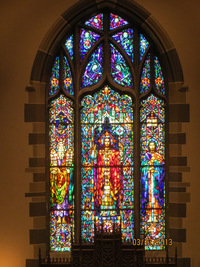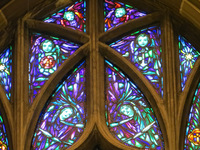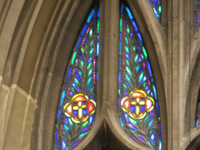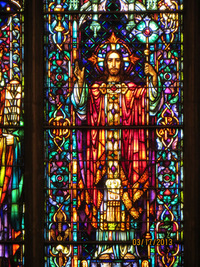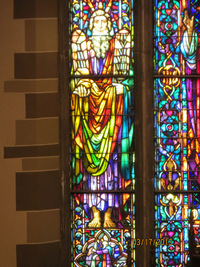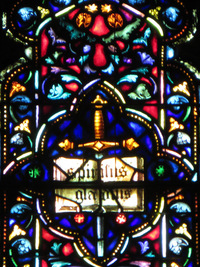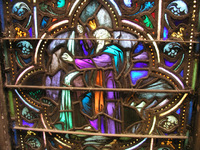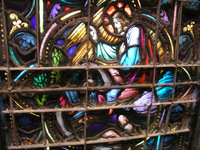Window
Building Name: First United Methodist ChurchStudio Name: Von Gerichten Studios
City: Kalamazoo
Window Shape: 6 (gothic arched, more than 2 vertical sections)
Subject/Title of Window: The Chancel Window, The Salvation of Man
Brief Description of Subject: Facing the worshipping congregation is the chancel window, filled with symbols which proclaim the tenets of our Christian faith. At the peak of the arched window are eight small panels which remind us of the lovely message of Christmas. On either side is a five pointed star, symbolic of that star which shone above the manger of Bethlehem and guided the wise men in their search for the newborn King. In the center panels are six cherubs, reminding us of the heavenly choir which sang, “Glory to God in the highest and on earth peace, good will toward men” (Luke 2:14). Two of these cherubs with infant faces and wings hold symbols of hope, the anchor, and the messianic rose. This conventionalized figure of the wild rose is found in scores of places throughout the sanctuary. It symbolizes the better day which was to be ushered in by God’s Messiah. Lower we find two panels on each side with the palm branches which are associated with the modern observance of Palm Sunday, and which remind us of the Saviour’s triumphal entry into Jerusalem when the multitude welcomed Him with the enthusiastic acclamation (Matthew 21:8-9), “Hosanna to the Son of David: blessed is he that cometh in the name of the Lord.” Superimposed upon each palm branch is the messianic rose, imprinted with the cross, since it was through the cross that He was most truly revealed as God’s chosen Messiah. The tall panel on the left represents the Old Testament and presents its leading character, Moses, who wielded a greater influence upon the nation’s development than any other person before Christ. Above His head we wee the T cross, about which a serpent is entwined. This reminds us of that occasion when the children of Israel, traveling toward the promised land, were beset by a plague of poisonous snakes and were saved through Divine intervention (Numbers 21:9). Moses set up a cross with a brazen serpent upon it and all who sought the Divine protection at this shrine were healed, thus illustrating in a way which Israel never forgot, that God can turn even the suffering of men into a means of their redemption. To this incident Jesus referred when He said (John 3:14-5), “As Moses lifted up the serpent in the wilderness, even so must the son of man be lifted up: that whosoever believeth on Him should not perish, but have eternal life.” Beneath the feet of Moses is a small panel depicting another incident of the wilderness pilgrimage, when the people of Israel were dying of thirst in the desert. Under the guidance of God, Moses struck a great rock with his sacred staff and a spring of crystal water gushed forth (Numbers 20”1-11). Through such incidents Israel learned the hard lesson of faith in the providence of God. In his hands Moses bears his greatest contribution to the moral development of mankind – The Ten Commandments. From his head shine rays of light, symbolic of the divine illumination which made his soul radiant after his many days of intimate communion with God upon the lowly summit of Mount Sinai. The stone tablet on our left reminds us of the other commandments which concern our relationships with our fellowmen. These two groups of the commandments were summarized by the rich young ruler when he said, in response to Jesus’ question about the law, “Thou shalt love the Lord thy God with all they heart, soul, mind and strength, and thy neighbor as thyself” (Luke 10:25-28). The tall panel on the opposite side represents the New Testament. The central figure is St. Paul, who was not only the author of many books of the New Testament, but actually did more than any other person save Christ himself, to found the Christian Church, define and establish its doctrines, and transform the Christian movement from a small Jewish sect into a world religion. Beneath his feet is a small panel depicting his conversion on the road to Damascus, whither he was bound to destroy the remnants of the Christian congregation which had been driven from Jerusalem (Acts 9:1-9). Above his head is the cross hilted sword, symbol of militant and determined endeavor. The hilt ends in a globe, symbolic of the universal mission of the church. The Bible bears the Latin words, “Spiritus Gladius” which means “The sword of the Spirit.” In the portrait, St. Paul holds these symbols in his hands. His militant spirit could not be turned aside from its divinely appointed purpose by dangers, threats, imprisonment, scourging or even death itself. But the weapon of his warfare was the truth of God, found in His Holy Word, as Paul himself said (Ephesians 6:17), “And take the sword of the spirit which is the word of God.” Between the Old and New Testament panels stands the figure of our Redeemer. Beneath his feet is a small panel portraying His baptism in which He humbly dedicated His life to the accomplishment of the will of God. On either side, as we ascend, we find the symbols of the Holy Communion: on the left three heads of wheat, representing the bread, and on the right a bunch of grapes, representing the wine. Next above we find again two forms of sacred monogram. On the left is the monogram HIS, standing for Jesus. On the right is the XP, standing for Christ. These letters beginning and ending the Greek alphabet, suggest that Jesus’ revelation of God is complete and final. These sacred monograms taken together proclaim our Lord’s name, Jesus, his title, Christ; and his eternal significance, the first and the last. The next higher panel on the right portrays the lamb, symbol of Christ’s sacrificial death, accompanied by the scarlet cross upon the white banner of ultimate victory, reminding us of that sacrifice which Christ made upon Calvary’s cross of our redemption. In the opposite panel, we discover the chalice of the sacrament of Holy Communion, the sacred memorial of Christ’s sacrificial death, in the observance of which we follow His request, “Do this in remembrance of me” (I Corinthians 11:24-25). At the peak of this panel is the triple pointed crown of triumph, and below it, four conventionalized representations of the bursting pomegranate, symbolic of resurrection. The central and most commanding figure of the entire chancel window is that of Jesus Christ himself. Artists have portrayed Him in many different forms. He has been pictured as the compassionate Christ, healing the sick; as the gentle Christ, bidding the children to come unto Him; as the teaching Christ, with the multitudes gathered about Him; as the meek and lowly Nazarene receiving Judas’ kiss of betrayal and the Roman scourging without resentment; and as the suffering Christ, crowned with thorns and nailed to the Cross. But this window represents Christ with a different emphasis. This is the Christ of authority. He stands erect and tall. His garments are not the plain, simple clothes of the Galilean peasant, but rich robes of velvet purple and scarlet, embroidered with gold. They are the robes of a King. About his neck and hanging to his knees is a gold embroidered stole set with seven rare and beautiful jewels, symbolic of the seven gifts ascribed to the Saviour by the vast multitude of the heavenly choir (Revelation 5:12), “Worthy is the Lamb that was slain to receive power, and riches, and wisdom, and strength and honor, and glory and blessing.” This verse was used by Handel as the theme of the “Hallelujah Chorus” in his oratorio The Messiah. The stole ends in a gold pendant bearing the figure of a scorpion, symbol of the power to punish and correct the evil doer. These are the accouterments of One who has fulfilled His divinely appointed mission upon earth. All of its humiliation, disappointment and pain are in the past; and now He stands forth clothed with divinely authority, triumphant over sin and death and worthy of the title bestowed by the Heavenly Host (Revelation 19:16), “King of Kings and Lord of Lords,” teaching us anew that lesson which history so simply demonstrated in the events of 1939-45: that though evil may triumph for a season, the will of God must at last prevail. In His left hand He holds a scepter surmounted by the Cross and globe, symbolic of the fact the ultimately the entire world will come to acknowledge Him. When we rise to leave the sanctuary and to go forth to face anew the tasks and problems of life, our last glimpse of this majestic figure reveals Christ’s right hand raised in benediction and assurance as though He would say to us as He said to His disciples when departing from their sight, (Matthew 28:18-20), “All power is given unto Me in heaven and in earth. Go ye, therefore, and teach all nations, baptizing them in the name of the Father, and of the Son and of the Holy Spirit; teaching them to observe all things whatsoever I have commanded you, and lo, I am with you always even unto the end of the world.”
Inscriptions: Spiritus Gladius
Condition of Window: Very Good
Height: 30'
Width: 9.5'
Type of Glass and Technique: Antique or Cathedral Glass, Lead Came
The Chancel Window - The Salvation of Man
Six Cherubs with anchor and messianic rose
Palm branches at top of Chancel Window
Glorification of Our Lord
Moses in the Chancel Window
St. Paul in the Chancel Window
Spiritus Gladius in the Chancel Window
Moses strikes the rock in the Chancel Window
The conversion of St. Paul in the Chancel Window
The MSGC is a constantly evolving database. Not all the data that has been collected by volunteers has been sorted and entered. Not every building has been completely documented.
All images in the Index are either born-digital photographs of windows or buildings or are scans of slides, prints, or other published sources. These images have been provided by volunteers and the quality of the material varies widely.
If you have any questions, additions or corrections, or think you can provide better images and are willing to share them, please contact donald20@msu.edu

